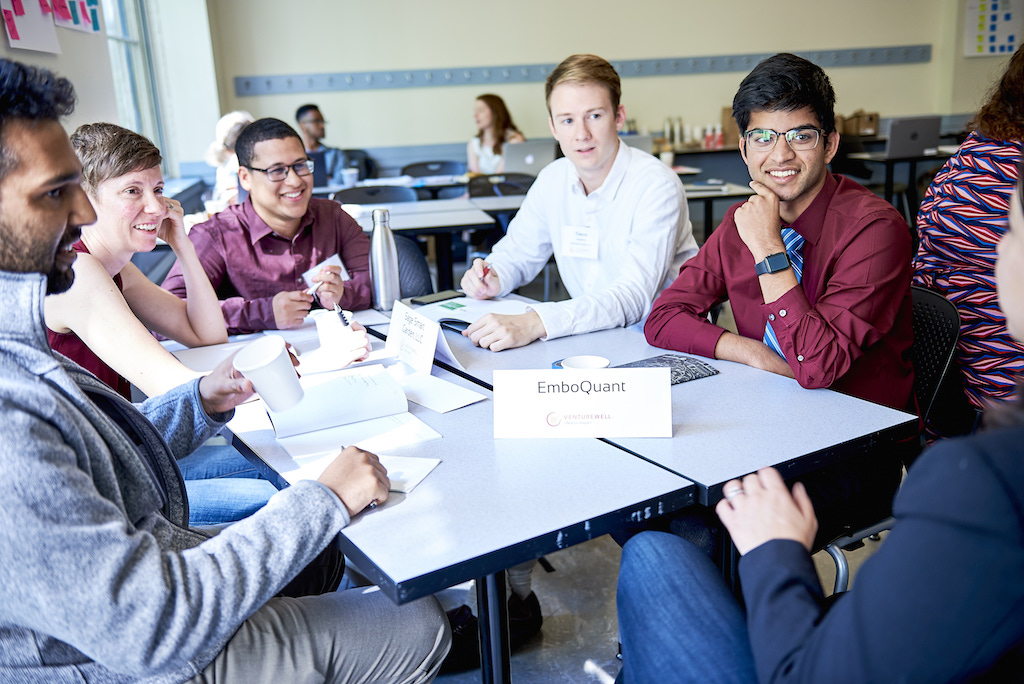
We updated this article to include a new class exercise. The article was originally published on August 21, 2018.
How can you continually maintain student engagement in the classroom? Class exercises can boost engagement, but it can be tricky to know which activities will amplify innovative thinking. That’s why we curated a collection of cutting-edge class exercises used by some of our faculty grantees. These class exercises are designed to prepare student innovators at the earliest stage of their entrepreneurship journey, helping them take the first steps toward transforming their ideas into impactful inventions and ventures.
From systems thinking to design sprints, take inspiration from these innovative class exercises to help you refine your own coursework for maximum impact.
 1) The Pin-Up Exercise
1) The Pin-Up Exercise
Raja Schaar, Drexel University
“I LOVE a pin-up. Constructive critiques of projects has really helped my students grow their ideas. These daily conversations also help me understand my students, gauge their learning, and assess how the class is progressing. I try to switch up the format regularly. Some days it’s a game, some days it’s formal, but it’s always about open conversation.”
 2) The Systems Thinking Exercise
2) The Systems Thinking Exercise
Jeremy Faludi, Dartmouth College
“In the VentureWell-supported online course, Tools for Design and Sustainability, there’s a section called Whole System Mapping. It’s a way of both making people better at systems thinking in a very simple, visual way, and incorporating quantitative sustainability measurements (like life-cycle assessment) into the early-stage invention process. The exercise uses systems thinking to help inventors make their product or service more sustainable while still meeting users’ needs.”
 3) The 48-Hour Crash Course Exercise
3) The 48-Hour Crash Course Exercise
Nathalie Duval-Couetil, Purdue University
“In a New Product Development course, I created a “crash course” activity that had to be completed and presented during the first week of class. Student teams were given products ranging from toys to air fresheners. In 48 hours, they had to create pitches on how to improve these products. The idea was to give them a clear sense of the scope of what they would learn throughout the semester.”
 4) The Design with Empathy Exercise
4) The Design with Empathy Exercise
Eric Lima, Cooper Union for the Advancement of Science and Art
“For a freshman design class, I ran a Design Thinking module before I eased into a Lean Launchpad module. The module helped connect students with real people facing real challenges. It was based on the IDEO approach of interviewing the people you are trying to serve to build empathy with them and uncover the underlying (non-obvious) challenges they experience. The process led to insights that redefined the scope of student projects, which improved the overall design of the deliverable.”
 5) The Tinker Toy Exercise
5) The Tinker Toy Exercise
Steve Tello, UMass Lowell
“The idea of the Tinker Toy Challenge is to engage students who have not yet worked together in creative problem-solving and teamwork. Tinker Toys are sorted by shape and color into separate bags and tucked under chairs or placed on a table. Matching colors and pieces are placed together. We then present a challenge such as building a vehicle to transport a sick individual across rugged terrain. However, before students can start building, they have to build a team with students who have a different shape or color in order to gather sufficient pieces to build the vehicle.”
 6) The Wallet Exercise
6) The Wallet Exercise
Grant Warner, Howard University
“I used Stanford d.school’s Wallet Exercise with a group of mechanical engineering students enrolled in the Capstone Design/Senior Project. The exercise emphasizes the importance of developing empathy, leveraging short design sprints, and building low fidelity prototypes. These are important lessons for the class and their professional careers moving forward.”
 7) The Pitch Competition Exercise
7) The Pitch Competition Exercise
Gary Brooking, Wichita State University
“I teach a biodesign class that focuses on the design process. During the first week of class, students are asked to pitch what they think is the greatest problem that must be solved. The students vote on which problems to tackle. Half of the ideas are cut. The class then breaks up into teams of two. The teams develop innovative solutions to a problem, and pitch their ideas along with their value proposition, market opportunities, revenue model, etc. Another round of voting and cuts take place. The students then form teams of four to further refine their solutions. Introducing competition and fear of failure increases student engagement. Most recover well from the failure and jump in with the new team to win the next stage.”
For many students, their first exposure to innovation and entrepreneurship happens in your classroom. That’s why it’s important to continuously develop and improve upon class exercises to prepare students to launch a journey to solve the world’s biggest problems through innovation.
How do you determine what resources student inventor-entrepreneurs need—and when? Use our Venture Development Framework to help inform the development, implementation, and evaluation of programs supporting early-stage innovators.
For more class exercise ideas, check out these related resources:
8 class activities to stimulate inventor entrepreneurs
activities for teaching innovation: game-based learning
online education resources for innovation and entrepreneurship educators
VentureWell Course and Program Grants provide up to $30,000 to faculty or staff with innovative ideas to help students hone the skills needed to create novel STEM-based inventions and bring their ideas to market.